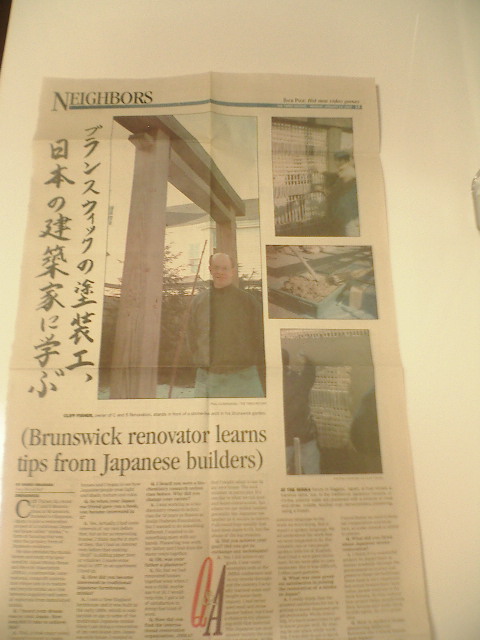新聞社インターン時の執筆記事
Brunswick renovator learns tips from Japanese builders
1/14/2002
By SHOKO HISANAGA
Times Record staff
Brunswick

Cliff Fisher, 55, owner of C and S Renovations in Brunswick, traveled to Okayama, Japan, to join a restoration project of a traditional Japanese house called "minka," a form of housing that was once the primary form of Japanese residence.
He also attended the minka forum and study trip sponsored by Japan Minka Reuse and Recycle Association (JMRA), a nationwide, international, nonprofit association whose aim is to restore and recycle minka as a link between suppliers and users of materials from demolished minka.
Q. I heard your dream was to visit Japan. How long did it take to achieve this?
A. Well, it took many years. I wanted to travel to Japan since I was a young adult, because of my interests in Japanese culture and architecture and Japanese elements of houses, light and shade, color and texture. At my first job I worked with many Japanese people and ever since then I've wanted to go and see Japan for myself. It's been 25 years.
Q. When did you first become aware of Japanese houses?
A. I think one of my Japanese friends back in the 1970s gave me a book on Japanese houses and I began to see how Japanese people treat light and shade, texture and color.
Q. So when your Japanese friend gave you a book, you became interested in it?
A.Yes. Actually, I had some interests of my own before that, but as far as renovating houses, I think maybe it started then. But I had an interest even before that making "shoji" (a sliding paper door or window). I made some shoji in 1977 in an apartment I lived in.
Q. How did you become interested in traditional Japanese farmhouses, minka?
A.I own a New England farmhouse and it was built in the early 1800s, which is comparable in age to some of the traditional Japanese minka. Since I am doing a renovation of my own house into Japanese-style house, I wanted to see for myself what the traditional houses looked like and how they were built.
Q. When did you learn that there were some similarities between New England farmhouses and Japanese farmhouses?
A.I have, for many years, been interested in having a Japanese style house, but I didn't know that there were some similarities between minka and this style house until about two years ago. That's when I began studying Japanese minka.
Q. I heard you were a biochemistry research technician before. Why did you change your career?
A.I was working as a biochemistry research technician for 10 years in Boston at Joslin Diabetes Foundation, but I wanted to do something different. I wanted to do something more with my hands. Plastering was work my father and I had done for many years together.
Q. Oh, was your father a plasterer?
A.No, but we had renovated houses together even when I was a child, maybe age 9 or 10. I would help him. I got a lot of satisfaction in doing that kind of work.
Q. How did you find the international restoration organization, JMRA?
A.I ran across JMRA through the Internet. I wrote them and explained that I was interested in doing a renovation of my own house in the Japanese style. Since it's a volunteer organization, I asked if there were any possibilities to volunteer some time and they wrote back and said "Yes."
Q. When you decided to join the program, what did you want to learn from the minka restoration?
A.I mainly wanted to see the structural parts of minka that I might adapt to use in my own house. The roof member in particular. It's similar to what we call post-and-beam construction, but where we use milled lumber, generally, the Japanese use lumber as it occurs in nature: Full round logs usually that have been made to fit, but the shape of the log remains.
Q. Did you achieve your goal? Did you get to exchange any techniques?
A.Yes, I did achieve my goals. I saw many examples both at the JMRA conference and in my travels throughout the country. I actually learned some and taught some (techniques). I had never used mud before, but I had a chance to try plastering with that material. The Japanese use mud plaster mainly for exterior wall construction. At the conference I was able to see it done and actually try to do some. Then in Okayama I demonstrated skim coat techniques using modern Japanese acrylic plaster products.
Q. What was the biggest problem for you when you plastered the minka in Okayama? Did you experience any problem caused by language or cultures? If you did, how did you solve the problem?
A.Language was the biggest problem. We had a common language in the work we were doing. But it wasn't a spoken language. We all understood the work that we were supposed to do. Fortunately one or two people spoke a little bit of English. And I had a very good dictionary. So we were able to communicate. But it was difficult. I often used gestures.
Q. What was your greatest satisfaction in joining the restoration of a minka in Japan?
A.I really think that the greatest satisfaction for me is getting to know Japanese people personally. While traveling, it's hard sometimes to get to know people well. By staying in one place while working, I was able to get to know people very well. That was very pleasant.
Q. How is plastering different between the United States and Japan?
A.Plastering is quite different between the older houses in Japan and the older houses in the United States. In Japan humidity is so high, so walls and the plaster product is made from naturally occurring products, such as straw and mud, to allow walls to breathe. In the United States we need to keep out temperature and moisture, so some cement is added to plaster.
Q. What did you think about Japanese minka restoration?
A.I think it's a wonderful project. In Japan there is money available through the government to restore and preserve these old buildings. Since land is very expensive but actual houses have little value, people tend not to fix their houses. So this restoration project helps people keep their houses and make them livable again. So it's a great idea.
Q. How is modern house plastering different between the United States and Japan?
A.I think it's not so different, but I think a different product is used in Japan. It is a two-part system. One part is used to seal the existing mud wall. The second part is a modern, probably recycled acrylic product used to skim coat. It has sand-like texture.
Q. I'm not sure whether recycled old minka can withstand earthquakes. What do you think about this?
A.Well, actually, these structures have stood for hundreds of years and probably have been through earthquakes. The way the house is designed, it sits on a stone or concrete platform, and maybe that allows it to withstand earthquakes. Also, the architecture in Japan is such that no nails were used. In the United States we use fasteners of many kinds, both screws and nails. In Japan it's all either joinery or peg. So nothing is fixed and the structure is able to move and bend a little more (than) our buildings can.
Q. Did you interact with people in Japan when you traveled?
A.I would interact with people to figure out how to get some place. I would either use my maps to ask "Where is this?" or I would say a word or two about where I was trying to go and point in the direction and hope they could help me find my way. I found many Japanese people willing to help.
Q. What do you think about traditional houses in Japan? How about houses that mixed Western and Japanese styles of buildings?
A.I really liked the traditional houses in Japan more than the modern houses in Japan, because, for one thing, Japanese use very many different styles of roofing materials, which are very beautiful. We tend to use different colors of the same product, so everything looks quite similar. There is more interest in Japan now in having houses that are insulated but the body of the house in Japan tends to be very similar to American houses now. Just the roofs are different.
Q. There are some types of Japanese traditional building. Are you especially interested in Japanese traditional folk house, minka or do you have another preference?
A.I am specifically interested in minka because of the style of roof architecture. I would like to be able to adapt that kind of design to my own renovation. I can't expect to use a thatched roof in this climate (in Maine), because it's too wet here, but the structure of minka I would like to reproduce (in) my own house.
Q. What difference did you see in how to use space -- the United States vs. Japan?
A.I think the main thing is that in Japan space is at a premiun. People don't have large space to live in. They have to make use of small spaces for many purposes, so the use of sliding doors, fusuma or shoji, permits one room to be used, for instance, as the bedroom at night and living room during the day. Whereas we have more room to live in, so we can have separate rooms for each purpose.
Q. What do you think about that idea-- using two rooms as one larger room by opening sliding doors?
A.I like the idea of having multiple uses for one room. We have the luxury to have a separate kitchen, a separate bathing, a separate sleeping area, but I think that use of sliding wall units, fusuma or shoji, is a more beautiful style.
Q. I heard you are planning to make and sell Japanese traditional items such as shoji. Are you expecting potential clients?
A.Yes. I think that the Japanese style is very popular in the United States right now. I am thinking of trying to find a market for things that you might find in Japanese houses, such as fusuma or shoji, maybe some furniture, tatami, etc. I'm not sure if I will be successful, but I would like to try.
Q. Why do you think Japanese style is popular among people in the United States?
A.Well, I think people are coming to appreciate uses of light and shade. It's very simple, yet beautiful. Maybe there was a resistance after the war to things Japanese in the United States, but I think right now there is a renewed interest. The simple beauty of Japanese style is very attractive to people, and more accepted.
Q. What was the most interesting thing in Japan ? What impressed you the most in Japan?
A.I guess I didn't realize how big the cities are in Japan. I expected that Japan would be much more rural, but in fact the cities were enormous. I guess I was impressed by feeling safe. People did not come up to you on a street to ask for money or to try to get you to do something for them. And I felt very safe to walk on the streets at night even with $2,000 in my pocket. I never felt any kind of danger situation. Most of my time in Japan was spent in big cities. I was definitely safer in Japan.
Q. How do you think your experience will help your work in the future?
A.I guess not so much in my work but in my own renovation. I don't know if I could use anything that I learned in Japan in my work here, but I could certainly use some of the techniques in my own house.
Q. What would you like to do for the local community through your experiences?
A.I guess I would like to share any knowledge that I have. If other people had interests in having an authentic Japanese-style room, I would be willing to help them accomplished that.
Shoko Hisanaga is a Japanese intern learning about publishing at The Times Record.







